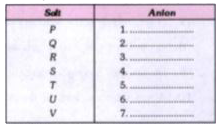On gradual addition of KI solution to Bi(NO3)3 solution initially produces a dark brown precipitate which dissolves in excess of KI to give a clear yellow solution. Given an explanation for above observations.
Bi(NO3)3 undergoes hydrolysis to give HNO3 (oxidising agent) which liberates l2 (dark brown ppt) from Kl solution, iodine (I2) dissolves in excess of Kl to give KI3 (yellow solution)
(a) Bi(NO3)3+H2O→[Bi(OH)(NO3)2]+HNO3
(b) 6I−+2NO−3+8H+→2NO2+4H2O+3I2
(c) KI+I2→KI3 (Yellow solution).
Topper's Solved these Questions
- BOOK - AAKASH INSTITUTE ENGLISHCHAPTER - THE P-BLOCK ELEMENTSEXERCISE - Assignment Section-J)16videos
THE P-BLOCK ELEMENTS
- BOOK - AAKASH INSTITUTE ENGLISHCHAPTER - THE P-BLOCK ELEMENTSEXERCISE - Assignment Section-H)10videos
THE P-BLOCK ELEMENTS
- BOOK - AAKASH INSTITUTE ENGLISHCHAPTER - THE D AND F-BLOCK ELEMENTS EXERCISE - Assingment ( Section-J Aakash Challengers Questions )10videos
THE D AND F-BLOCK ELEMENTS
- BOOK - AAKASH INSTITUTE ENGLISHCHAPTER - THE S-BLOCK ELEMENTSEXERCISE - Assignment (Section-J)10videos
THE S-BLOCK ELEMENTS
Similar Questions
On gradual addition of KI solution to Bi(NO3)3 solution initially produces a dark brown precipitate which dissolves in excess of KI to give a clear yellow solution. Given an explanation for above observations.
View SolutionGradual addition of KI solution to Bi(NO3)3 solution initially produces a dark brown precipitate which dissolves in excess of KI to give a clear yellow solution. Write chemical equation for the above reactions.
View SolutionWhen a KI solution is added to a metal nitrate, a black precipitate is produced which dissolves in an excess of KI to give an organge solution. The metal ion is:
View SolutionWhich of the following precipitate(s) does /do not dissolve in excess of ammonia solution ?
View SolutionA solution of a metal ion when treated with KI solution gives a red precipitate which dissolves in excess of KI solution to give a colourless solution. Moreover, the solution of the same metal ion on treatment with the solution of cobalt (II) thiocyanate gives rise to a deep blue crystalline precipitate. The metal ion is
View SolutionA white substance (A) reacts with dilute H2SO4 to produce a colourless suffocating gas (B) and a colourless solution (C )/ The reaction of gas (B) with potassium iodate and starch solution produce a blue colour solution. Aqueous Solution of (A) gives a white precipitate with BaCl2 solution which is soluble in dilute HCl. Addition of aqueous NH3 or NaOH to (C ) produced first a precipitate which dissolves in excess of the respective reagent to poduced a clear solution. Similarly addition of excess of potassium ferrocyanide to (C ) produced a precipitate (D) which also dissolves in aqeous NaOH giving a clear solution. Identify (A),(B),(C ) and (D ). Write the equation of the reactions involved.
View SolutionAddition of HCl to an aqueous solution of Pb(NO3)2 gives a
View SolutionWhich of the following precipitate is soluble in excess of NH3 solution?
View SolutionSalts P, Q,R,S,T,U and V undergo reactions (i) to (vii) respectively. Identify the cation present in these salts on the basis of these reactions. Tabulate your answer in the formate given below.
(i) When the salt Pis heated with sodium hydroxide solution a vigorous reaction takes place and a colourless gas is evolved with a pungent and suffocating smell that brings tears in our eyes. The evolved gas gives dense white fumes with a moist glass rod depped with hydrochloric acid.
(ii) Addition of sodium hydroxide solution to a solution of salt Q gives a thick white precipitae which is soluble in excess of sodium hydroxide solution to form a clear solution.
(iii) Addition of ammonium hydroxide solution to a solution of salt R gives a dark blue precipitate which is soluble is excess of ammonium hydroxide solution to form an intense deep blue solution.
(iv) Addition of ammonium hydroxide solution to a solution of 5 gives a dirty green [bottle green] precipitate which is insoluble even in the excess of ammonium hydroxide solution.
(v) Addition of ammonium hydroxide solution to a solution of T gives a reddish brown (rust precipitate] precipitate which is insoluble even in the excess of ammonium hydroxide solution.
(vi) Addition of ammonium hydroxide solution to a solution of V gives a geletaneous white precipitate which is soluble in excess of ammonium hydroxide solution to form a clear solution.
(vii) Addition of ammonium hydroxide solution to a solution of V gives no precipitate but it gives a chalky white precipitate with sodium hydroxide solution which is insoluble even in the excess of sodium hydroxide solution.
 View Solution
View SolutionA white substance A reacts with dilute H2SO4 is produce a colourless B and acidified K2Cr2O7 solution produces a green solution and a slighly coloured precipitate D .The substance B to burns in air to produce a gas E which reacts with B ito yied D and a colouless liquid .Anhyhdrous copper sulphate is turned blue on addition of this colourless liquid addition od aqueous NH3orNaOH to C produce first a precipitate which dissolve in the excess of the respective reagent to produce a clear solution in each case identify A,B,C, and E. Write the equation of the reaction involved.
View Solution

